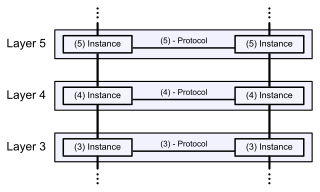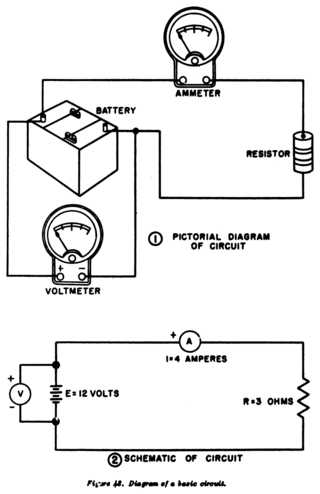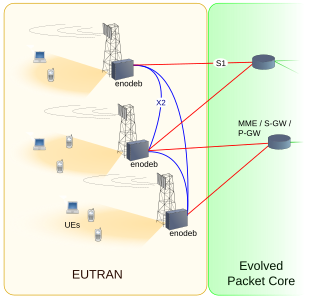
The Open Systems Interconnection model is a reference model from the International Organization for Standardization (ISO) that "provides a common basis for the coordination of standards development for the purpose of systems interconnection." In the OSI reference model, the communications between systems are split into seven different abstraction layers: Physical, Data Link, Network, Transport, Session, Presentation, and Application.

A wireless network is a computer network that uses wireless data connections between network nodes. Wireless networking allows homes, telecommunications networks and business installations to avoid the costly process of introducing cables into a building, or as a connection between various equipment locations. Admin telecommunications networks are generally implemented and administered using radio communication. This implementation takes place at the physical level (layer) of the OSI model network structure.
Network, networking and networked may refer to:

Network topology is the arrangement of the elements of a communication network. Network topology can be used to define or describe the arrangement of various types of telecommunication networks, including command and control radio networks, industrial fieldbusses and computer networks.
In a telecommunications network, a link is a communication channel that connects two or more devices for the purpose of data transmission. The link may be a dedicated physical link or a virtual circuit that uses one or more physical links or shares a physical link with other telecommunications links.
giFT Internet File Transfer (giFT) is a computer software daemon that allows several file sharing protocols to be used with a simple client having a graphical user interface (GUI). The client dynamically loads plugins implementing the protocols, as they are required.
Zigbee is an IEEE 802.15.4-based specification for a suite of high-level communication protocols used to create personal area networks with small, low-power digital radios, such as for home automation, medical device data collection, and other low-power low-bandwidth needs, designed for small scale projects which need wireless connection. Hence, Zigbee is a low-power, low-data-rate, and close proximity wireless ad hoc network.

A circuit diagram is a graphical representation of an electrical circuit. A pictorial circuit diagram uses simple images of components, while a schematic diagram shows the components and interconnections of the circuit using standardized symbolic representations. The presentation of the interconnections between circuit components in the schematic diagram does not necessarily correspond to the physical arrangements in the finished device.
The Radio Network Controller (RNC) is a governing element in the UMTS radio access network (UTRAN) and is responsible for controlling the Node Bs that are connected to it. The RNC carries out radio resource management, some of the mobility management functions and is the point where encryption is done before user data is sent to and from the mobile. The RNC connects to the Circuit Switched Core Network through Media Gateway (MGW) and to the SGSN in the Packet Switched Core Network.
The Internet Radio Linking Project, also called IRLP links amateur radio stations around the world by using Voice over IP (VoIP). Each gateway consists of a dedicated computer running custom software that is connected to both a radio and the Internet. This arrangement forms what is known as an IRLP Node. Since all end users communicate using a radio as opposed to using a computer directly, IRLP has adopted the motto "Keeping the Radio in Amateur Radio".

A wireless mesh network (WMN) is a communications network made up of radio nodes organized in a mesh topology. It can also be a form of wireless ad hoc network.

EchoLink is a computer-based Amateur Radio system distributed free of charge that allows radio amateurs to communicate with other amateur radio operators using Voice over IP (VoIP) technology on the Internet for at least part of the path between them. It was designed by Jonathan Taylor, a radio amateur with call sign K1RFD.
High-availability clusters are groups of computers that support server applications that can be reliably utilized with a minimum amount of down-time. They operate by using high availability software to harness redundant computers in groups or clusters that provide continued service when system components fail. Without clustering, if a server running a particular application crashes, the application will be unavailable until the crashed server is fixed. HA clustering remedies this situation by detecting hardware/software faults, and immediately restarting the application on another system without requiring administrative intervention, a process known as failover. As part of this process, clustering software may configure the node before starting the application on it. For example, appropriate file systems may need to be imported and mounted, network hardware may have to be configured, and some supporting applications may need to be running as well.
The Hazy-Sighted Link State Routing Protocol (HSLS) is a wireless mesh network routing protocol being developed by the CUWiN Foundation. This is an algorithm allowing computers communicating via digital radio in a mesh network to forward messages to computers that are out of reach of direct radio contact. Its network overhead is theoretically optimal, utilizing both proactive and reactive link-state routing to limit network updates in space and time. Its inventors believe it is a more efficient protocol to route wired networks as well. HSLS was invented by researchers at BBN Technologies.

High-speed multimedia radio (HSMM) is the implementation of high-speed wireless TCP/IP data networks over amateur radio frequency allocations using commercial off-the-shelf (COTS) hardware such as 802.11 Wi-Fi access points. This is possible because the 802.11 unlicensed frequency bands partially overlap with amateur radio bands and ISM bands in many countries. Only licensed amateur radio operators may legally use amplifiers and high-gain antennas within amateur radio frequencies to increase the power and coverage of an 802.11 signal.

A computer network is a set of computers sharing resources located on or provided by network nodes. Computers use common communication protocols over digital interconnections to communicate with each other. These interconnections are made up of telecommunication network technologies based on physically wired, optical, and wireless radio-frequency methods that may be arranged in a variety of network topologies.

E-UTRA is the air interface of 3rd Generation Partnership Project (3GPP) Long Term Evolution (LTE) upgrade path for mobile networks. It is an acronym for Evolved UMTS Terrestrial Radio Access, also known as the Evolved Universal Terrestrial Radio Access in early drafts of the 3GPP LTE specification. E-UTRAN is the combination of E-UTRA, user equipment (UE), and a Node B.
A wireless ad hoc network (WANET) or mobile ad hoc network (MANET) is a decentralized type of wireless network. The network is ad hoc because it does not rely on a pre-existing infrastructure, such as routers or wireless access points. Instead, each node participates in routing by forwarding data for other nodes. The determination of which nodes forward data is made dynamically on the basis of network connectivity and the routing algorithm in use.
Gigabit Home Networking (G.hn) is a specification for wired home networking that supports speeds up to 2 Gbit/s and operates over four types of legacy wires: telephone wiring, coaxial cables, power lines and plastic optical fiber. Some benefits of a multi-wire standard are lower equipment development costs and lower deployment costs for service providers.
A DX cluster is a network of computers, each running a software package dedicated to gathering, and disseminating, information on amateur radio DX activities.







